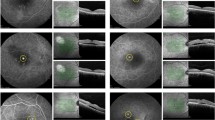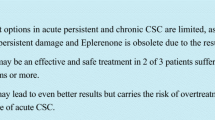Abstract
Purpose
To evaluate the safety and efficacy of selective retina therapy (SRT) with real-time feedback-controlled dosimetry (RFD) in the treatment of chronic central serous chorioretinopathy (CSC).
Methods
In this retrospective case series study, 50 eyes of 49 patients with chronic CSC demonstrating focal or diffuse foveal leakages on fundus fluorescein angiography (FFA) were included. Following evaluation of test spots at temporal arcades, SRT (wavelength 527 nm, pulse repetition rate 100 Hz, pulse energy ramp with maximal 15 pulses) with retinal spot diameter of 200 μm was applied to the areas of each leakage observed on fluorescein angiography. Changes in mean best corrected visual acuity (BCVA), maximum macular thickness (MMT), subretinal fluid (SRF) height, and subfoveal choroidal thickness (SCT) were evaluated at 1, 2 and 3 months after treatment. RFD was used for adjusting the pulse energy. Eyes received a mean of 21.1 ± 18.1 treatment spots with a range of energies between 50uJ and 200uJ per pulse.
Results
Subretinal fluid (SRF) was completely resolved in 74% (37/50 eyes) at month 3. Mean BCVA (LogMAR) was improved from 0.44 ± 0.29 at baseline to 0.37 ± 0.32 at month 3 (p = 0.001). MMT was decreased from 335.0 ± 99.8 μm at baseline to 236.4 ± 66.4 μm after 3 months (p < 0.001). SRF height was decreased from 168.0 ± 77.3 μm at baseline to 29.0 ± 57.3 μm after 3 months (p < 0.001). However, the changes in SCT were not statistically significant (p = 0.48).
Conclusions
SRT treatment with RFD showed favorable visual and anatomical outcomes in patients with chronic CSC.






Similar content being viewed by others
References
Nicholson B, Noble J, Forooghian F, Meyerle C (2013) Central serous chorioretinopathy: update on pathophysiology and treatment. Surv Ophthalmol 58:103–126
Wang M, Munch IC, Hasler PW, Prunte C, Larsen M (2008) Central serous chorioretinopathy. Acta Ophthalmol 86:126–145
Spaide RF, Campeas L, Haas A, Yannuzzi LA, Fisher YL, Guyer DR, Slakter JS, Sorenson JA, Orlock DA (1996) Central serous chorioretinopathy in younger and older adults. Ophthalmology 103:2070–2079 discussion 2079-2080
Guyer DR, Yannuzzi LA, Slakter JS, Sorenson JA, Ho A, Orlock D (1994) Digital indocyanine green videoangiography of central serous chorioretinopathy. Arch Ophthalmol 112:1057–1062
Spaide RF, Goldbaum M, Wong DW, Tang KC, Iida T (2003) Serous detachment of the retina. Retina 23:820–846 quiz 895-826
Spitznas M (1986) Pathogenesis of central serous retinopathy: a new working hypothesis. Graefes Arch Clin Exp Ophthalmol 224:321–324
Klein ML, Van Buskirk EM, Friedman E, Gragoudas E, Chandra S (1974) Experience with nontreatment of central serous choroidopathy. Arch Ophthalmol 91:247–250
Gilbert CM, Owens SL, Smith PD, Fine SL (1984) Long-term follow-up of central serous chorioretinopathy. Br J Ophthalmol 68:815–820
Bujarborua D (2001) Long-term follow-up of idiopathic central serous chorioretinopathy without laser. Acta Ophthalmol Scand 79:417–421
Koskela P, Laatikainen L, von Dickhoff K (1994) Contrast sensitivity after resolution of central serous retinopathy. Graefes Arch Clin Exp Ophthalmol 232:473–476
Moon JW, Yu HG, Kim TW, Kim HC, Chung H (2009) Prognostic factors related to photodynamic therapy for central serous chorioretinopathy. Graefes Arch Clin Exp Ophthalmol 247:1315–1323
Reibaldi M, Cardascia N, Longo A, Furino C, Avitabile T, Faro S, Sanfilippo M, Russo A, Uva MG, Munno F, Cannemi V, Zagari M, Boscia F (2010) Standard-fluence versus low-fluence photodynamic therapy in chronic central serous chorioretinopathy: a nonrandomized clinical trial. Am J Ophthalmol 149(307–315):e302
Lai TY, Chan WM, Li H, Lai RY, Liu DT, Lam DS (2006) Safety enhanced photodynamic therapy with half dose verteporfin for chronic central serous chorioretinopathy: a short term pilot study. Br J Ophthalmol 90:869–874
Ruiz-Moreno JM, Lugo FL, Armada F, Silva R, Montero JA, Arevalo JF, Arias L, Gomez-Ulla F (2010) Photodynamic therapy for chronic central serous chorioretinopathy. Acta Ophthalmol 88:371–376
Khosla PK, Rana SS, Tewari HK, Azad RU, Talwar D (1997) Evaluation of visual function following argon laser photocoagulation in central serous retinopathy. Ophthalmic Surg Lasers 28:693–697
Little HL (1976) Complications of argon laser retinal photocoagulation: a five-year study. Int Ophthalmol Clin 16:145–159
Brinkmann R, Roider J, Birngruber R (2006) Selective retina therapy (SRT): a review on methods, techniques, preclinical and first clinical results. Bull Soc Belge Ophtalmol 302:51–69
Schuele G, Elsner H, Framme C, Roider J, Birngruber R, Brinkmann R (2005) Optoacoustic real-time dosimetry for selective retina treatment. J Biomed Opt 10:064022
Park YG, Seifert E, Roh YJ, Theisen-Kunde D, Kang S, Brinkmann R (2014) Tissue response of selective retina therapy by means of a feedback-controlled energy ramping mode. Clin Exp Ophthalmol 42:846–855
Kim HD, Han JW, Ohn YH, Brinkmann R, Park TK (2014) Functional evaluation using multifocal electroretinogram after selective retina therapy with a microsecond-pulsed laser. Invest Ophthalmol Vis Sci 56:122–131
Roider J, Liew SH, Klatt C, Elsner H, Poerksen E, Hillenkamp J, Brinkmann R, Birngruber R (2010) Selective retina therapy (SRT) for clinically significant diabetic macular edema. Graefes Arch Clin Exp Ophthalmol 248:1263–1272
Kang S, Park YG, Kim JR, Seifert E, Dirk TK, Ralf B, Roh YJ (2016) Selective retina therapy in patients with chronic central serous Chorioretinopathy: a pilot study. Medicine (Baltimore) 95:e2524
Park YG, Kim JR, Kang S, Seifert E, Theisen-Kunde D, Brinkmann R, Roh YJ (2016) Safety and efficacy of selective retina therapy (SRT) for the treatment of diabetic macular edema in Korean patients. Graefes Arch Clin Exp Ophthalmol 254:1703–1713. doi:10.1007/s00417-015-3262-1
Roider J, Brinkmann R, Wirbelauer C, Laqua H, Birngruber R (2000) Subthreshold (retinal pigment epithelium) photocoagulation in macular diseases: a pilot study. Br J Ophthalmol 84:40–47
Klatt C, Saeger M, Oppermann T, Porksen E, Treumer F, Hillenkamp J, Fritzer E, Brinkmann R, Birngruber R, Roider J (2011) Selective retina therapy for acute central serous chorioretinopathy. Br J Ophthalmol 95:83–88
Elsner H, Porksen E, Klatt C, Bunse A, Theisen-Kunde D, Brinkmann R, Birngruber R, Laqua H, Roider J (2006) Selective retina therapy in patients with central serous chorioretinopathy. Graefes Arch Clin Exp Ophthalmol 244:1638–1645
Klatt C, Elsner H, Porksen E, Brinkmann R, Bunse A, Birngruber R, Roider J (2006) Selective retina therapy in central serous chorioretinopathy with detachment of the pigmentary epithelium. Ophthalmologe 103:850–855
Yasui A, Yamamoto M, Hirayama K, Shiraki K, Theisen-Kunde D, Brinkmann R, Miura Y, Kohno T (2016) Retinal sensitivity after selective retina therapy (SRT) on patients with central serous chorioretinopathy. Graefes Arch Clin Exp Ophthalmol. doi:10.1007/s00417-016-3441-8
Author information
Authors and Affiliations
Corresponding author
Ethics declarations
Funding
No funding was received for this research.
Conflict of interest
All authors certify that they have no affiliations with or involvement in any organization or entity with any financial interest or non-financial interest in the subject matter or materials discussed in this manuscript.
Ethical approval
All procedures performed in studies involving human participants were in accordance with the ethical standards of the institutional and/or national research committee and with the 1964 Helsinki Declaration and its later amendments or comparable ethical standards.
Informed consent
Informed consent was obtained from all individual participants included in the study.
Financial interest
None of the authors has any financial interest in any of the products described.
Electronic supplementary material
ESM 1
(DOC 22 kb)
(MOV 23005 kb)
Rights and permissions
About this article
Cite this article
Park, Y.G., Kang, S., Kim, M. et al. Selective retina therapy with automatic real-time feedback-controlled dosimetry for chronic central serous chorioretinopathy in Korean patients. Graefes Arch Clin Exp Ophthalmol 255, 1375–1383 (2017). https://doi.org/10.1007/s00417-017-3672-3
Received:
Revised:
Accepted:
Published:
Issue Date:
DOI: https://doi.org/10.1007/s00417-017-3672-3




